Magazine
Academic Stars

More than 8,000 Indian professors are enriching university campuses all across America.
|
Homi K. Bhabha, professor of English and American Literature and Language at Harvard University and one of the world’s leading theorists in postcolonial studies, acknowledges a tinge of irony in a native of a former colony teaching English in the West.
“Yes, there is a certain kind of irony,” he says. “It’s not so much that we teach the ex-colonizers English, because the people we teach nowadays are also themselves not necessarily brought up with an imperial cast of mind. I think a number of us have opened up in the Western academy different ways of interpreting, not only non-Western cultures, but also Western cultures themselves.” Earlier this year, Critical Inquiry, the preeminent interdisciplinary journal of cultural and literary theory, reviewed the most cited scholars in its pages during its 30-year history. Bhabha ranked 27th, tied with Aristotle, no less. Bhabha, who is also director of the Harvard Humanities Center, has growing company. Indians are the largest foreign student pool on American campuses and almost two-thirds of all Indian-Americans have a college degree, well over twice the national average. So it should come as no surprise that an estimated 8,000 Indian-American faculty members – predominantly in sciences and engineering, but also increasingly in the humanities and social sciences – teach at universities across the United States. In their interactions with millions of young minds, imparting knowledge, ideas, concepts, and philosophies, setting students on the road to successful careers – and sometimes even helping them change the world around them – faculty members like Bhabha are on the front lines of Indian influence on America.
In an era of the global economy, some of the brightest minds shaping international economic thought include the crème de la crème of Indian academics, such as Amartya Sen at Harvard University, Cambridge, Mass., and Jagdish Bhagwati at New York’s Columbia University. Sen, who received the Nobel Prize in Economics in 2005, has been Master of Trinity College in Cambridge and was awarded the Bharat Ratna, the highest civilian honor given by the Indian government. Bhagwati, whose name often crops up in talk of future Nobel laureates, is one of the leading free-trade economists in the world and has contributed immensely to the debate on international trade policy, migration and economic hreforms in India. Bhagwati and his wife Padma Desai, also an economics professor at Columbia, co-authored a book on economic hreforms in India 20 years before they were implemented. Prime Minister Manmohan Singh joked recently with American CEOs at a luncheon in New York that had Bhagwati’s prescriptions been followed, they could as easily have assembled in India as in New York. The impact of Indian academics is being felt all the way to the International Monetary Fund, where Raghuram G. Rajan is Economic Counselor and Director of Research. The first person of Indian origin – and the youngest person ever – to be chief economist at IMF, Rajan is returning to the University of Chicago’s Graduate School of Business, from which he has been on leave as professor of finance. Indian academics are making their mark in every discipline. “You take any field and the top people are Indian,” says Bhagwati, who has authored scores of seminal books and papers in his field. “The only thing we haven’t got into yet is the Mafia. But then I think, maybe we have, but just haven’t been caught yet!” he jokes.
Bhabha explains the rise of Indian intellectuals who were brought up in post-colonial India: “We were deeply immersed in Western ideas and Western languages and Western cultures, while also being very much a part of our own Indian societies and traditions and values. So we shine a kind of double light on the European tradition and we, who came from a colonial society, which was in some ways considered culturally inferior, are now in position to show, to demonstrate what is sophisticated cultural supremacy, to show off the problems with cultures or languages or societies, which see themselves as superior, because they happen to have political power.” Bhabha grew up in Bombay before leaving for Oxford to study and eventually teach. “My memories of Bombay are very rich and full memories, because Bombay was and continues to be an enormously dynamic city,” he says. After graduating from Elphinstone College, he went to study in England at Christchurch College, where he says, “I found in some ways England was more narrow minded, more provincial, more full of preconceptions than my experience in Bombay.” He mocks Thomas Macaulay’s admonition that a single shelf of a good European library is worth the whole native literature of India and Arabia, pointing out that today subaltern historians like Salman Rushdie, Arundhati Roy and Kiran Desai are not only contributing to their own cultures and societies, but also in some ways changing the way the West looks at itself.
And not just in the realm of cultural and literary theory. Indians have long been a force on college campuses in science and technology, since early Indian immigration was driven by students coming for the master’s or Ph.D. programs at U.S. universities, many of whom ended up in academic careers until opportunities opened up in corporate America in the 1990s. Some of the pioneering efforts in the information technology sector, for example, started at Carnegie Mellon University in Pittsburgh, Pa., where Raj Reddy, professor of computer science and robotics, was founding director of Carnegie Mellon’s Robotics Institute, the nation’s first when it was established in 1979. Imagine having a math conjecture named after you. Shreeram Shankar Abhyankar, professor of mathematics and computer science and industrial engineering at Purdue University in West Lafayette, Ind., developed Abhyankar’s conjecture of finite group theory, which he explored in his doctoral thesis in 1957. This award winning mathematician recalls that his father, also a mathematician, introduced him to mathematics and Sanskrit poetry by teaching him portions of Bijaganita, Bhaskaracharya’s 1150 A.D. treatise on algebra. Another Indian professor with a theorem named after him is Anil Nerode, professor of mathematics at Cornell University in Ithaca, N.Y., who with John Myhill proved the Myhill-Nerode Theorem, specifying necessary and sufficient conditions for a formal language to be regular. If you have benefited from laser surgery, you have to thank C. Kumar N. Patel, vice chancellor for research at the University of California, Los Angeles, and professor of physics. In 1963, Patel developed the carbon dioxide laser that is used as a laser scalpel in surgery. He was awarded the National Medal of Honor by President Clinton in 1996 for his invention, which has had significant impact in the industrial, scientific, medical and defense fields.
George Sudarshan, professor of physics at the University of Texas at Austin, is noted for his seminal work in quantum optics, most notably the Sudarshan-Glauber representation, which won Roy J Glauber the 2005 Nobel Prize in Physics, stirring a minor controversy after several physicists complained that Sudarshan should have shared in the honor. And if you think robots are limited to science fiction, Pradeep Khosla, dean of the Carnegie Institute of Technology and co-director of CyLab has some amazing, thinking robots to make your future life easier. Khosla has been elected to the prestigious National Academy of Science for his innovative work. Padma Desai, professor of comparative economic systems and director of Columbia’s Center for Transition Economies, is one of the world’s leading experts on the Russian economy. She was appointed U.S. treasury advisor to the Russian Finance Ministry in 1995 and her decades of research on the Soviet economy culminated in Conversations on Russia: Reform from Yelstin to Putin, which the Financial Times named one of the best books of 2006. When Desai was growing up in Surat, her father was an English professor who brought home tons of books – Thomas Hardy, William Shakespeare, Charles Dickens and Fyodor Mikhailovich Dostoevsky. “When I read Crime and Punishment at the age of 13, I told myself I had to read this in the original Russian,” recalls Desai. “And that’s how I became a Russia area specialist.” When she went to Harvard on a fellowship, she also studied Russian: “It’s a beautiful language. It is the one language, which in its syntax, in its grammatical construction and its musicality, comes close to Sanskrit, which I also learned.”
Most Indian academics came to America as students seeking higher education. India has a centuries old tradition of the guru-shishya relationship – that of teacher and student – and somehow it just seems appropriate that this relationship is continuing in America. Gayatri Chakravorty Spivak, professor of humanities and director of the Center for Comparative Literature and Society at Columbia University, is one of the country’s foremost literary theorists and renowned for the controversies she stirs. She has become almost a cult figure on campus, known for speaking her mind. Apart from her own writings, she has translated French philosopher Jacques Derrida and Bengali writer Mahasweta Devi. She is a vocal advocate for women’s rights and rural literacy. Indian academics are also turning up in the upper power echelons of universities. Beheruz N. Sethna, professor of business administration, is in his 12th year as president of the University of West Georgia, Carrollton, Ga., which has a budget of $100 million and 100 programs of study through the doctoral level. Currently he’s also serving as interim executive vice chancellor and chief academic officer for the University System of Georgia, which covers 35 institutions.
Michael Rao is president of Central Michigan University in Mount Pleasant, Mich. He heads one of the country’s largest campuses with a student body of 28,000. Previously he served as president of Mission College in California’s Silicon Valley and chancellor of Montana State University Northern in Havre, Mont. Before he turned to politics, Bobby Jindal became the University of Louisiana’s youngest president ever in 1999, taking the post at just 28-years-old. Until recently, Arjun Appadurai was provost and senior vice president for academic affairs at The New School, New York. There are also at least a dozen Indian-American deans, such as Ajay Menon, dean of College of Business, at Colorado State University, Fort Collins, Colo., and Yash Gupta, dean of Marshall School of Business at the University of Southern California, Los Angeles. Dipak C. Jain is dean of Kellogg School of Management at Northwestern University, Evanston, Ill., and also professor of entrepreneurial studies. In 2003, he was appointed foreign affairs adviser to the Prime Minister of Thailand and has consulted with major companies from Microsoft to American Express. Ask Jain if he’s seeing more Indians in academia now, and he says, “Absolutely. The way you could come to the U.S. was based on education, because U.S. immigration focused on professionals and most of the people who came to do higher studies – some decided to move to academia and others to the corporate sector.” Pradeep Khosla is Dean of the School of Engineering at Carnegie Institute of Technology, with a research focus on cyber security and security of embedded software. His high-end research has had a direct impact on practice: it’s been incorporated into commercial products, such as direct-drive robots, used in electronic assembly.
Khosla, who is from Indian Institute of Technology Kharagpur, was elected to the prestigious National Academy of Engineering, honoring those who have had an impact on engineering research and practice. He says, “I don’t know of any department in the country that has no professors of Indian origin. If you look at the statistics, when I was being educated, and even 10 years ago, 90 percent of the IITians came to the U.S., one way or the other. “It’s actually a really big number and I think it’s made a very big impact on the graduate research in the U.S. and also on the entrepreneurship in the U.S. At one time 50 percent of the entrepreneurs in Silicon Valley were of Asian origin, Indian or Chinese, in the dotcom base.” Is there advantage to being Indian? “I don’t think that’s important. I think most people don’t succeed or don’t do well because they are afraid of work or are afraid to take risks. Whether it’s research or entrepreneurship, unless you go above and beyond, you don’t progress,” Khosla says. Then there’s a huge contingent of some of the best writers of Indian origin who are writing in English and teaching at American universities. Imagine being a student of English and taking classes from Salman Rushdie!
Rushdie has joined the faculty of Emory University in Atlanta, to which he has entrusted his papers, as distinguished writer in residence, a five-year appointment in the English department. “The teaching appointment of Salman Rushdie, and the significance of his archive, underscore the importance of the humanities in addressing the global issues of our day,” says Emory provost Earl Lewis. Several noted Indian-American writers teach creative writing, including Bharati Mukherjee and Vikram Chandra at UC Berkeley, Chitra Banerjee Divakaruni at the University of Houston and Meena Alexander at Hunter College and the Graduate Center of the City of New York. Amitava Ghosh has taught at Columbia and City University of New York and has been a visiting professor of English at Harvard. Anita Desai taught for several years at the Massachusetts Institute of Technology, Cambridge. Their reputations aside, the Indian academics say they get their greatest pleasure from teaching. When Bhagwati turned 70, his students organized not one, but three conclaves to honor him, in an outpouring of affection. “Doing research is just half of being a professor. You have to give of yourself. In my 25 years I’ve never cut a class or outsourced it to somebody else. A university has two major functions – one is to create knowledge and two, to teach students how to practice virtue, to use the knowledge to good purpose,” Bhagwati says. Padma Desai is equally dedicated to teaching. Recently she injured her knee, went to the emergency room on Friday and was in class on Monday, painfully, in a walker. A popular teacher, she once had a class of 400 undergraduates, one of the largest on campus. “It was a performance. It was the next best thing to being on Broadway! I enjoy teaching and chasing ideas,” she jokes. “My father was a college professor for 40 plus years and so it’s in my genes. You cannot write knowingly, scientifically, analytically, unless you’re constantly interacting with students and colleagues in a very challenging and stimulating university environment. And that is what American universities provide you with. There’s continuous interaction,” Desai says. “If you have an idea, your idea travels further and forward when you talk with students – and I find that very exciting. American students are a big challenge. They are very outspoken, very frank and very inquisitive. So teaching is not only stimulating; it’s a very joyful experience with a lot of energy in the classroom.”
Indian academics abandon the dense prose of their professions and wax poetically of their homeland. Take Bhabha, who in 1998 received the dubious distinction of runner-up in the “Bad Writing Competition,” from the journal, Philosophy and Literature, in recognition of “bad writing from the most stylistically lamentable passages found in scholarly books and articles.” There’s a lilt in Bhabha’s hreflections on India: “There are all kinds of things which tie you to India. Family, one’s memories, but also the food, the climate, the architecture. When I arrive back in Bombay, I take my first shower, and I wear my cotton clothes and I go for a little walk. I feel wonderfully at home and relaxed.” He adds, “I’m very engaged and enthralled with the lively and very varied intellectual cultures of India. What I really love is to walk the streets of Bombay, to be even parked in a car or sitting on a bench. I’m never bored, even if I have to wait for somebody for an hour. I’m just completely absorbed by the manifold lives and people. It’s a very social and communicative society with people always wanting to tell each other things or stories or jokes or sing songs, to participate in a public life. The civic life is rich in that way.” And surely that seeps into his thought process, his writings and his teaching? “There’s no question about that,” he says. “There is a kind of loquaciousness, this desire to communicate, to converse, to share, which is very much a part of the Indian experience. It’s not a world of compartments, it’s not a world of stiff retention; it’s a world of extension.”
|


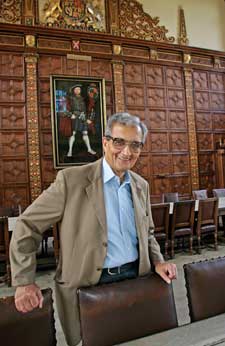


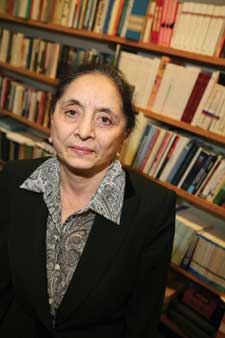
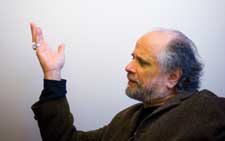

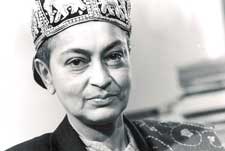
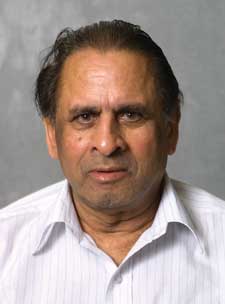
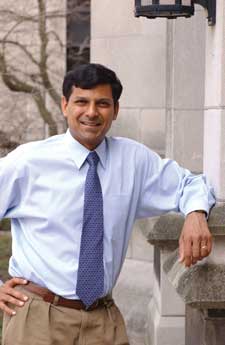

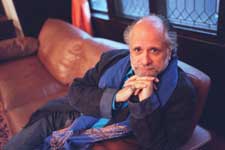
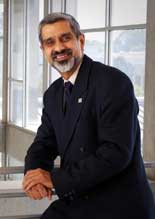
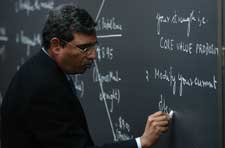
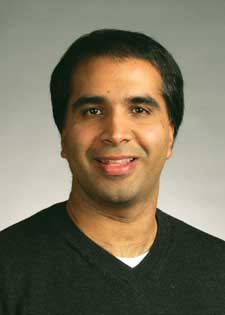
You must be logged in to post a comment Login